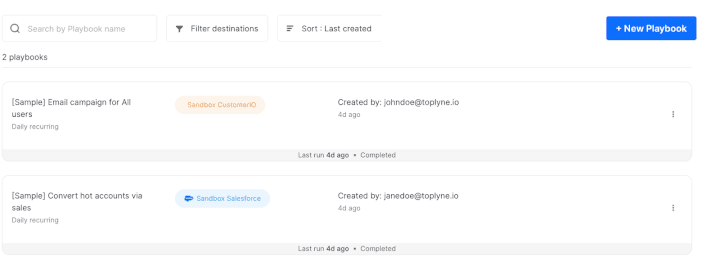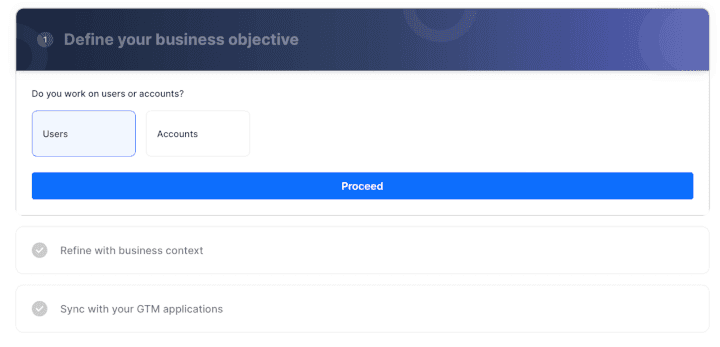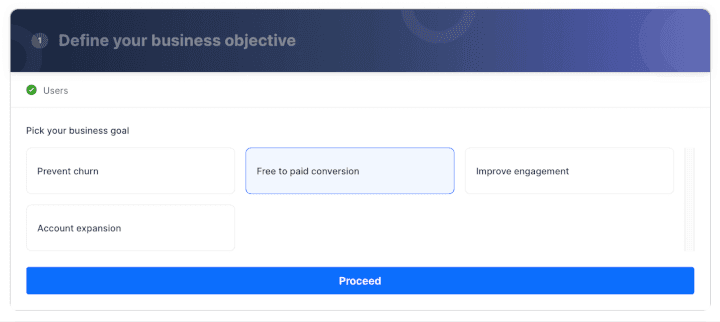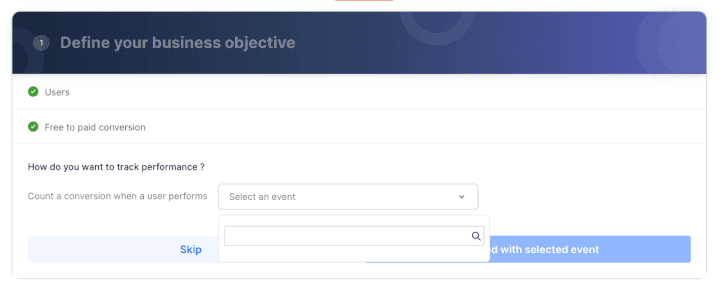How to Strike a Balance Between Free Users Vs Paying Users
How to Strike a Balance Between Free Users Vs Paying Users
How to Strike a Balance Between Free Users Vs Paying Users
Discover the perfect free user vs paying user ratio, why free users matter, and tips for converting them to paid ones.
Discover the perfect free user vs paying user ratio, why free users matter, and tips for converting them to paid ones.
Discover the perfect free user vs paying user ratio, why free users matter, and tips for converting them to paid ones.



While being “best friends forever” with your paying customers is important, you can’t afford to ignore your free users.
Why?
You never know which free users will become paying users down the road.
And without proper attention and guidance, converting those free users will be as challenging as surviving a game of Jumanji!

Don’t worry. We’re here to guide you through this!
In this article, we’ll explore four ways to strike a balance between the number of free users vs paying users. We’ll also cover why non paying users matter and give you handy tips to convert them into paid customers.
Ready, set?
Welcome to the jungle!
Free User Vs Paying User: Four Ways to Strike the Perfect Balance
When you have too many free users, your paid users are *literally* paying the price for the rest.
But when your free users are few, your paid user acquisition rate will suffer. 👀
Trying to strike a balance between the two?
Here are the four fool-proof tactics to win the free user vs paying user game 🎮:
1. Choose the Right Pricing Model
Once your users complete their free trial or hit the paywall in their freemium plan, ensure you have a variety of paid plans to offer.
Why?
Giving a trial user a variety of paid tier options can encourage them to convert.
For example, Spotify Premium is available for individuals, duos, families, and students. Likewise, Google Workspace (formerly G Suite) offers various paid plans based on individual users' needs.
This way, users aren’t forced to use a one-size-fits-all paid plan and can choose one that suits their needs and budget!
That said, you must balance how you and the user benefit from these acquisition models.

You don’t want to give away all your powers for free and get nothing in return. 🤷
Here are a few pricing approaches you could try to boost user acquisition and achieve a favorable free trial conversion rate:
Flat rate: Charge all your customers equally, and they all have access to the same paid features. On the downside, only offering a flat rate can make it challenging to upsell and appeal to smaller businesses.
Tiered: Group your paid app features into packages and charge a higher price for more advanced features.
Per user: Charge per user for the paid app. This works best for app purchases aimed at teams.
Usage-based: Charge depending on how actively a customer uses your product. This is an excellent option for products like email marketing tools.
2. Know What Type of Feedback to Prioritize
Like it or not:
You need to gather feedback from a trial user and paying customers to stay connected and boost user acquisition.

But the feedback you receive from a free user will likely differ from that of a paying user.
Why?
A paid account holder is more familiar with the ins and outs of your product, so they’ll usually ask you to make things faster or easier to use.
On the other hand, free users are more likely to ask questions about the product’s suitability.
Prioritize the feedback you receive from paying users over those who just signed up.
After all, they’re the ones bringing in the money. 💰
While collecting paid user feedback, consider when you’re collecting it and what purpose the data serves.
Paid user feedback can be divided into three types:
Point of conversion feedback: After a customer opts for your paid app, you should immediately ask about their payment experience. Crucially, ask them what tipped them towards conversion.
Proactive feedback: Actively seek feedback about the user experience. You can request such feedback from a new user through proactive onboarding.
Net Promoter Score (NPS): This metric is valuable when a customer has had some time to experience your product. The main question to ask: “How likely are you to recommend our product to others?” This tells you how happy your customers are.
But don’t ignore the opinions of your freemium users!
If several freemium users ask the same question or request the same feature, you may boost your free trial conversion rate if you listen to them.
3. Identify The Right Ratio of Free vs Paid Users For Your Industry
The proportion of free vs paid app users will depend on:
The product
Your target audience

Keep reading!
If you’re in a niche industry with no competition, it’s not surprising to have a large number of paid account users who want to use a premium feature right from the start.
But if you have a product in a highly competitive space like CRM tools, it’s normal to have many freemium app users. This allows a new user to try out your product and compare it with the other options on the market.
But that’s not all!
You also need to find a balance between your free and premium feature offerings.
If the freemium plan isn’t attractive enough, users won’t convert.
If the freemium app is too feature-rich, users won’t feel the need to upgrade.
The solution?
Allow app users to experience key functions of your product in a limited capacity and lock the premium features behind the paywall.
4. Ensure Your Paying Share Is Increasing
To ensure that your app purchases are increasing and your business is growing, you (the owner and app developer) need to focus on a crucial metric: Paying Share.
What’s this?
Paying share is the app usage share of paying users out of all active users.
However, a higher paying share doesn’t automatically indicate higher monetization.
You’ll also need to consider the Average Revenue Per Paying User (ARPPU), i.e., how much money each paying user brings in on average.
So, the right way to calculate revenue is:

Here’s an example:
Suppose you have 10,000 active users with an initial paying share of 20% and an ARPPU of $4. This means that 20% of your total users are paying an average of $4 per head.
Your revenue would be: (20%*10,000) x $4 = $8000
If your ARPPU drops from $4 to $3, but your paying share (paid app usage) keeps increasing — say from 20% to 40% — your revenue will still go up:
New revenue = (40%*10,000) x $3 = $12,000
Our point?
As long as your paying share keeps increasing, you can increase your monetization even if your ARPPU drops.
But how do you do that?
By offering superior customer service and a better onboarding experience to every free user!
This will help them take the plunge and start paying.
Moreover, as your paid user acquisition rate increases, you can lower the cost barrier to onboard more users and even introduce different pricing tiers.
Quick Tip: If your app is listed on an app store (Google Play or Apple App Store), you could also look into app store optimization to increase your visibility and boost sales.
Okay, here’s a question you may have:
If all free users should become paid users, how can they help you while they’re still free?
Why Free Users Matter: Three Ways You Can Benefit From Them
Here are the three most significant benefits of having free app users:
1. Positive Reviews and Greater Brand Awareness
When was the last time you actually ate at a one-star-rated restaurant?
Can’t remember?
That’s because online reviews can make or break your company’s success.
A study showed that positive online customer reviews could encourage users to make a purchase.
This is why you need to keep a close eye on the feedback from non paying users.
Or prepare to be overtaken by competitors!

But that’s not the only reason.
Positive user feedback can also build your online business reputation and make your brand more trustworthy.
So engage with your free app users and give them a user experience that wows them enough to write a game-changing five-star review online ⭐⭐⭐⭐⭐.
2. Lead Generation Opportunities
Free trials are not a one-way street.
Many B2B and B2C product-led growth companies give away detailed free trials, ebooks, and other resources in exchange for their users’ email addresses.
It’s like giving them a taste of your most decadent cake 🍰 in exchange for their details.

This little “foot in the door” with free users is your opportunity to keep marketing your paid plan to them — or even upsell other products in the future.
Eventually, regardless of whether they opt for your paid subscription, a smooth free trial can turn your free users into brand advocates.
They may spread the word about your product’s use cases within their circles or on social media, helping you get more users!
Who doesn’t like some free publicity, right?
3. Product Usage Insights
Free users allow you to monitor app usage and identify common habits and preferences.
This can help you discover your products' most popular features and use them in your monetization strategy.
Likewise, you can analyze user journeys (precisely the point where they decided to quit) to implement product improvements.
Pro tip: Get juicy product usage data using Toplyne's integrations with Mixpanel and Amplitude!
Great, now you understand why you should nurture free users.
But how do you convert those free users into paid customers?
Four Tips to Convert Free Users into Paying Users
No matter how beneficial your free users are, when the time is right, it’s time to hit the ‘convert’ button and make them paid ones.
And how do you do this?
1. Offer a Reward for Converting Faster
You can offer free trial users a discount on the paid plan for the first month, a customer-only coupon, or a welcome gift if they convert by a certain date.
Rewards can give free users the “wow” factor they need to upgrade.

And if that’s not enough, the sense of urgency will push them to buy a paid subscription!
2. Make Upgrading Hassle-Free
Users don’t want to put up with months of marketing to arrive at a complicated paid subscription checkout.
Buying your product shouldn’t feel like doing an online course!
A crucial leg of your monetization strategy is to make upgrading hassle-free by:
Having simpler forms with limited fields for credit card details and more.
Offering self-service support.
Reassuring them with a time-bound money-back guarantee if they’re unhappy with the paid features.
3. Give Users Sufficient Time to Try Out Your Product
Typically, SaaS companies offer a two-week free trial before a user needs to pay for the app.
However, B2B SaaS users may need a longer trial period since multiple people are usually involved in the buying process.
So what’s the ideal duration?
Companies should limit their trial to how long it takes free users to reach their product’s Aha! moment.
Check in with the standard free trial duration in your industry to set the right time frame for your trial.
Important: Offer exceptional customer service throughout the trial period.
4. Use Toplyne to Recognize Free Users That are Ready to Convert!
How do you easily identify high-intent users that are worth your time and money?
Say hello to Toplyne!
Toplyne helps SaaS companies identify and focus on the users and accounts that are most likely to convert based on in-product actions.
Here’s what you can do with Toplyne:
Connect the tool with a product analytics source of your choice to monitor and leverage critical product usage data.

Create different Go-to-Market (GTM) Playbooks to use strategies like in-app nudges, sales assists, remarketing, and more.

Select your target audience for your GTM strategy:
Users or
Accounts based on your business objectives.

Choose a business objective for each Playbook:
Prevent churn: Stop customers from leaving your product
Free to paid conversion: Focus on converting free trial users into paying customers
Improve engagement: Boost customer engagement through sales and marketing efforts, self-service, and more.

Select a conversion Event or the type of user action that you want to be considered a conversion.

Choose User Personas based on your business objective and get engagement suggestions:
New users: Emails and targeted marketing
Dormant users: Marketing campaigns
Casual users: Emails and in-app nudges
Power users: Reach out for product reviews and feedback
Sync qualified users with your GTM apps (Salesforce, HubSpot) to stay focused on the right leads.

Companies like Canva, Invideo, and OpenPhone are already using Toplyne to filter out quality leads and nurture them.
So what are you waiting for?
Embark on a Successful Adventure with Toplyne!
Whether your product is new on the market or already established, you can’t underestimate the power of free users.
Provided they’re in the right proportion to your paid users.
Use the tips above to nurture them and get the most out of your free plans!
And most importantly, use a tool like Toplyne to identify the most promising free users and leverage the perfect marketing tactics to get them to convert!
Sign up for Toplyne for free today (no credit card required 😉) to focus only on the hottest and most qualified users!

While being “best friends forever” with your paying customers is important, you can’t afford to ignore your free users.
Why?
You never know which free users will become paying users down the road.
And without proper attention and guidance, converting those free users will be as challenging as surviving a game of Jumanji!

Don’t worry. We’re here to guide you through this!
In this article, we’ll explore four ways to strike a balance between the number of free users vs paying users. We’ll also cover why non paying users matter and give you handy tips to convert them into paid customers.
Ready, set?
Welcome to the jungle!
Free User Vs Paying User: Four Ways to Strike the Perfect Balance
When you have too many free users, your paid users are *literally* paying the price for the rest.
But when your free users are few, your paid user acquisition rate will suffer. 👀
Trying to strike a balance between the two?
Here are the four fool-proof tactics to win the free user vs paying user game 🎮:
1. Choose the Right Pricing Model
Once your users complete their free trial or hit the paywall in their freemium plan, ensure you have a variety of paid plans to offer.
Why?
Giving a trial user a variety of paid tier options can encourage them to convert.
For example, Spotify Premium is available for individuals, duos, families, and students. Likewise, Google Workspace (formerly G Suite) offers various paid plans based on individual users' needs.
This way, users aren’t forced to use a one-size-fits-all paid plan and can choose one that suits their needs and budget!
That said, you must balance how you and the user benefit from these acquisition models.

You don’t want to give away all your powers for free and get nothing in return. 🤷
Here are a few pricing approaches you could try to boost user acquisition and achieve a favorable free trial conversion rate:
Flat rate: Charge all your customers equally, and they all have access to the same paid features. On the downside, only offering a flat rate can make it challenging to upsell and appeal to smaller businesses.
Tiered: Group your paid app features into packages and charge a higher price for more advanced features.
Per user: Charge per user for the paid app. This works best for app purchases aimed at teams.
Usage-based: Charge depending on how actively a customer uses your product. This is an excellent option for products like email marketing tools.
2. Know What Type of Feedback to Prioritize
Like it or not:
You need to gather feedback from a trial user and paying customers to stay connected and boost user acquisition.

But the feedback you receive from a free user will likely differ from that of a paying user.
Why?
A paid account holder is more familiar with the ins and outs of your product, so they’ll usually ask you to make things faster or easier to use.
On the other hand, free users are more likely to ask questions about the product’s suitability.
Prioritize the feedback you receive from paying users over those who just signed up.
After all, they’re the ones bringing in the money. 💰
While collecting paid user feedback, consider when you’re collecting it and what purpose the data serves.
Paid user feedback can be divided into three types:
Point of conversion feedback: After a customer opts for your paid app, you should immediately ask about their payment experience. Crucially, ask them what tipped them towards conversion.
Proactive feedback: Actively seek feedback about the user experience. You can request such feedback from a new user through proactive onboarding.
Net Promoter Score (NPS): This metric is valuable when a customer has had some time to experience your product. The main question to ask: “How likely are you to recommend our product to others?” This tells you how happy your customers are.
But don’t ignore the opinions of your freemium users!
If several freemium users ask the same question or request the same feature, you may boost your free trial conversion rate if you listen to them.
3. Identify The Right Ratio of Free vs Paid Users For Your Industry
The proportion of free vs paid app users will depend on:
The product
Your target audience

Keep reading!
If you’re in a niche industry with no competition, it’s not surprising to have a large number of paid account users who want to use a premium feature right from the start.
But if you have a product in a highly competitive space like CRM tools, it’s normal to have many freemium app users. This allows a new user to try out your product and compare it with the other options on the market.
But that’s not all!
You also need to find a balance between your free and premium feature offerings.
If the freemium plan isn’t attractive enough, users won’t convert.
If the freemium app is too feature-rich, users won’t feel the need to upgrade.
The solution?
Allow app users to experience key functions of your product in a limited capacity and lock the premium features behind the paywall.
4. Ensure Your Paying Share Is Increasing
To ensure that your app purchases are increasing and your business is growing, you (the owner and app developer) need to focus on a crucial metric: Paying Share.
What’s this?
Paying share is the app usage share of paying users out of all active users.
However, a higher paying share doesn’t automatically indicate higher monetization.
You’ll also need to consider the Average Revenue Per Paying User (ARPPU), i.e., how much money each paying user brings in on average.
So, the right way to calculate revenue is:

Here’s an example:
Suppose you have 10,000 active users with an initial paying share of 20% and an ARPPU of $4. This means that 20% of your total users are paying an average of $4 per head.
Your revenue would be: (20%*10,000) x $4 = $8000
If your ARPPU drops from $4 to $3, but your paying share (paid app usage) keeps increasing — say from 20% to 40% — your revenue will still go up:
New revenue = (40%*10,000) x $3 = $12,000
Our point?
As long as your paying share keeps increasing, you can increase your monetization even if your ARPPU drops.
But how do you do that?
By offering superior customer service and a better onboarding experience to every free user!
This will help them take the plunge and start paying.
Moreover, as your paid user acquisition rate increases, you can lower the cost barrier to onboard more users and even introduce different pricing tiers.
Quick Tip: If your app is listed on an app store (Google Play or Apple App Store), you could also look into app store optimization to increase your visibility and boost sales.
Okay, here’s a question you may have:
If all free users should become paid users, how can they help you while they’re still free?
Why Free Users Matter: Three Ways You Can Benefit From Them
Here are the three most significant benefits of having free app users:
1. Positive Reviews and Greater Brand Awareness
When was the last time you actually ate at a one-star-rated restaurant?
Can’t remember?
That’s because online reviews can make or break your company’s success.
A study showed that positive online customer reviews could encourage users to make a purchase.
This is why you need to keep a close eye on the feedback from non paying users.
Or prepare to be overtaken by competitors!

But that’s not the only reason.
Positive user feedback can also build your online business reputation and make your brand more trustworthy.
So engage with your free app users and give them a user experience that wows them enough to write a game-changing five-star review online ⭐⭐⭐⭐⭐.
2. Lead Generation Opportunities
Free trials are not a one-way street.
Many B2B and B2C product-led growth companies give away detailed free trials, ebooks, and other resources in exchange for their users’ email addresses.
It’s like giving them a taste of your most decadent cake 🍰 in exchange for their details.

This little “foot in the door” with free users is your opportunity to keep marketing your paid plan to them — or even upsell other products in the future.
Eventually, regardless of whether they opt for your paid subscription, a smooth free trial can turn your free users into brand advocates.
They may spread the word about your product’s use cases within their circles or on social media, helping you get more users!
Who doesn’t like some free publicity, right?
3. Product Usage Insights
Free users allow you to monitor app usage and identify common habits and preferences.
This can help you discover your products' most popular features and use them in your monetization strategy.
Likewise, you can analyze user journeys (precisely the point where they decided to quit) to implement product improvements.
Pro tip: Get juicy product usage data using Toplyne's integrations with Mixpanel and Amplitude!
Great, now you understand why you should nurture free users.
But how do you convert those free users into paid customers?
Four Tips to Convert Free Users into Paying Users
No matter how beneficial your free users are, when the time is right, it’s time to hit the ‘convert’ button and make them paid ones.
And how do you do this?
1. Offer a Reward for Converting Faster
You can offer free trial users a discount on the paid plan for the first month, a customer-only coupon, or a welcome gift if they convert by a certain date.
Rewards can give free users the “wow” factor they need to upgrade.

And if that’s not enough, the sense of urgency will push them to buy a paid subscription!
2. Make Upgrading Hassle-Free
Users don’t want to put up with months of marketing to arrive at a complicated paid subscription checkout.
Buying your product shouldn’t feel like doing an online course!
A crucial leg of your monetization strategy is to make upgrading hassle-free by:
Having simpler forms with limited fields for credit card details and more.
Offering self-service support.
Reassuring them with a time-bound money-back guarantee if they’re unhappy with the paid features.
3. Give Users Sufficient Time to Try Out Your Product
Typically, SaaS companies offer a two-week free trial before a user needs to pay for the app.
However, B2B SaaS users may need a longer trial period since multiple people are usually involved in the buying process.
So what’s the ideal duration?
Companies should limit their trial to how long it takes free users to reach their product’s Aha! moment.
Check in with the standard free trial duration in your industry to set the right time frame for your trial.
Important: Offer exceptional customer service throughout the trial period.
4. Use Toplyne to Recognize Free Users That are Ready to Convert!
How do you easily identify high-intent users that are worth your time and money?
Say hello to Toplyne!
Toplyne helps SaaS companies identify and focus on the users and accounts that are most likely to convert based on in-product actions.
Here’s what you can do with Toplyne:
Connect the tool with a product analytics source of your choice to monitor and leverage critical product usage data.

Create different Go-to-Market (GTM) Playbooks to use strategies like in-app nudges, sales assists, remarketing, and more.

Select your target audience for your GTM strategy:
Users or
Accounts based on your business objectives.

Choose a business objective for each Playbook:
Prevent churn: Stop customers from leaving your product
Free to paid conversion: Focus on converting free trial users into paying customers
Improve engagement: Boost customer engagement through sales and marketing efforts, self-service, and more.

Select a conversion Event or the type of user action that you want to be considered a conversion.

Choose User Personas based on your business objective and get engagement suggestions:
New users: Emails and targeted marketing
Dormant users: Marketing campaigns
Casual users: Emails and in-app nudges
Power users: Reach out for product reviews and feedback
Sync qualified users with your GTM apps (Salesforce, HubSpot) to stay focused on the right leads.

Companies like Canva, Invideo, and OpenPhone are already using Toplyne to filter out quality leads and nurture them.
So what are you waiting for?
Embark on a Successful Adventure with Toplyne!
Whether your product is new on the market or already established, you can’t underestimate the power of free users.
Provided they’re in the right proportion to your paid users.
Use the tips above to nurture them and get the most out of your free plans!
And most importantly, use a tool like Toplyne to identify the most promising free users and leverage the perfect marketing tactics to get them to convert!
Sign up for Toplyne for free today (no credit card required 😉) to focus only on the hottest and most qualified users!

Related Articles




Behavioral Retargeting: A Game-Changer in the Cookieless Era
Unlock the power of behavioral retargeting for the cookieless future! Learn how it personalizes ads & boosts conversions. #behavioralretargeting




All of Toplyne's 40+ Badges in the G2 Spring Reports
Our customers awarded us 40+ badges in G2's Summer Report 2024.




Unlocking the Full Potential of Google PMax Campaigns: Mastering Audience Selection to Double Your ROAS
Copyright © Toplyne Labs PTE Ltd. 2024
Copyright © Toplyne Labs PTE Ltd. 2024
Copyright © Toplyne Labs PTE Ltd. 2024
Copyright © Toplyne Labs PTE Ltd. 2024